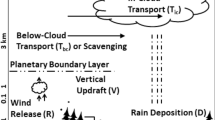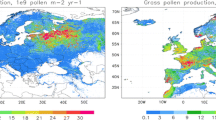Abstract
We present the extension and application of the mesoscale atmospheric meteorology model METRAS for dispersion of oak pollen. We incorporated functions for pollen emission, pollen viability and pollen deposition into METRAS and simulated pollen dispersal on a scale of up to 200 km. The basis of the simulations is a real landscape structure that includes topography, land use, and the location and size of oak stands. We simulated the oak pollen dispersion of one single oak stand with an estimated annual pollen production of 1 billion pollen grains/m2 forest surface on two exemplary days of the flowering season in 2000. Depending on the meteorological situation of the simulated days, a pollen cloud with about 10 pollen/m3 may extend up to 30 km from the source. Downstream of the oak stand, approximately 1,000 pollen/m2 deposited up to a distance of 25 km, and lower amounts of pollen deposited up to 100 km away. These values of pollen concentration and deposition lay within the range of published field studies. Overall, it is shown that mesoscale atmospheric models are applicable to simulate pollen dispersal on the landscape level.
Similar content being viewed by others
References
Aas, K., Aberg, N., Bachert, C., Bergmann, R., Bonini, S., Bousquet, J., et al. (1997). European allergy white paper: Allergic diseases as a public health problem. Brussels: The UCB Institute of Allergy.
Andersen, S. T. (1970). The relative pollen productivity and pollen representation of north European trees, and correction factors for tree pollen spectra, Geological Survey of Denmark, II. Series, No. 96.
Austerlitz, F., & Garnier-Géré, P. H. (2003). Modelling the impact of colonisation on genetic diversity and differentiation of forest trees: Interaction of life cycle, pollen flow and seed long-distance dispersal. Heredity, 90, 282–290.
Aylor, D. E. (2002). Settling speed of corn (Zea mays) pollen. Journal of Aerosol Science, 33, 1601–1607.
Chamberlain, A. C. (1975). The movement of particles in plant communities. In J. L. Monteith (Ed.), Vegetation and the atmosphere, Vol. 1 (pp. 155–203). London: Academic Press.
Degen, B., Llamas-Gomez, L., & Scholz, F. (1999). Erarbeitung von Entscheidungshilfen für eine nachhaltige Forstwirtschaft zum Schutze der genetischen Vielfalt von Waldbaum- und Waldstraucharten. In F. Scholz & B. Degen (Eds.), Wichtige Einflussfaktoren auf die Biodiversität in Wäldern, BFH-Mitt. No. 195 (pp. 1–139). Hamburg: Max Wiedebusch.
Degen, B., Streiff, R., & Ziegenhagen, B. (1999). Comparative study of genetic variation and differentiation of two pedunculate oak (Quercus robur) stands using microsatellite and allozyme loci. Heredity, 83, 597–603.
Dierer, S., Schlünzen, K. H., Birnbaum, G., Brümmer, B., & Müller, G. (2005). Atmosphere-sea ice interactions during a cyclone passage investigated by using model simulations and measurements. Monthly Weather Review, 133, 3678–3692.
DiFazio, S. P., Slavov, G. T., Burczyk, J., Leonardi, S., & Strauss, S. H. (2004). Gene flow from tree plantations and implications for transgenic risk assessment. In C. Walter & M. Carson (Eds.), Plantation forest biotechnology for the 21st century (pp. 405–422). Kerala: Research Signpost 37/661.
Dow, B. D., & Ashley, M. V. (1998). High levels of gene flow in bur oak revealed by paternity analysis using microsatellites. Journal of Heredity, 89, 62–70.
Ellstrand, N. C. (1992). Gene flow by pollen: Implication for the plant conservation genetics. Oikos, 63, 77–89.
Fladung, M. (2004). Modellierung des Genflusses für die Risikoabschätzung gentechnisch veränderter Bäume. Working Paper No. 2004/4, Institute for Forest Genetics and Forest Tree Breeding, Federal Research Centre for Forestry and Forest Products, Hamburg.
Gerber, S., Mariette, S., Streiff, R., Bodénès, C., & Kremer, A. (2000). Comparison of microsatellites and amplified fragment length polymorphism markers for parentage analysis. Molecular Ecology, 9, 1037–1048.
Giddings, G. (2000). Modelling the spread of pollen from Lolium perenne. The implications for the release of wind-pollinated transgenics. Theoretical and Applied Genetics, 100, 971–974.
Giddings, G. D., Sackville Hamilton, N. R., & Hayward, M. D. (1997). The release of genetically modified grasses. Part 2: The influence of wind direction on pollen dispersal. Theoretical and Applied Genetics, 94, 1007–1014.
Goyette-Pernot, J., Muñoz-Alpizar, R., Blanchet, J.-P., Goyette S., & Beniston, M. (2003). Analysing ragweed pollen cloud over Montreal City Center, in: Proceedings of the 5th International Conference on Urban Climate, Lodz.
Grosse-Brauckmann, G. (1978). Absolute Pollennieder-schlagsmengen an verschiedenen Beobachtungsorten in der BRD. Flora, 167, 209–247.
Helbig, N., Vogel, B., Vogel, H., & Fiedler, F. (2004). Numerical modelling of pollen dispersion on the regional scale. Aerobiologia, 20, 3–19.
Hidalgo, P. J., Mangin, A., Galán, C., Hembise, O., Vázquez, L. M., & Sanchez, O. (2002). An automated system for surveying and forecasting Olea pollen dispersion. Aerobiologia, 18, 23–31.
Hirst, J. M. (1952). An automatic volumetric spore trap. Annals of Applied Biology, 39, 257–265.
Jackson, S. T., & Lyford, M. E. (1999). Pollen dispersal models in Quaternary plant ecology: Assumptions, parameters, and prescriptions. Botanical Review, 65, 39–75.
Kawashima, S., & Takahashi, Y. (1995). Modelling and simulation of mesoscale dispersion process for airborne cedar pollen. Grana, 34, 142–150.
Kawashima, S., & Takahashi, Y. (1999). An improved simulation of mesoscale dispersion of airborne cedar pollen using a flowering-time map. Grana, 38, 316–324.
Klein, E. K., Lavigne, C., Foueillassar, X., Gouyon, P. H., & Laredo, C. (2003). Corn pollen dispersal: Quasi-mechanistic models and field experiments. Ecological Monographs, 73, 131–150.
Lahtinen, M.-L., Pulkkinen, P., & Helander, M. L. (1997). Potential gene flow by pollen between English oak (Quercus robur L.) stands in Finland. Forestry Studies, 28, 47–50.
Levin, D. A, & Kerster, K. W. (1974). Gene flow in seed plants. Evolutionary Biology, 7, 139–220.
Loos, C., Seppelt, R., Meier-Bethke, S., Schiemann, J., & Richter, O. (2003). Spatially explicit modelling of transgenic maize pollen dispersal and cross-pollination. Journal of Theoretical Biology, 225, 241–255.
Loveless, M. D., & Hamrick, J. L. (1984). Ecological determinants of genetic-structure in plant-populations. Annual Review of Ecology and Systematics, 15, 65–95.
Lüpkes, C., & Schlünzen, K. H. (1996). Modelling the Arctic convective boundary-layer with different turbulence parameterizations. Boundary-Layer Meteorology, 79, 107–130.
Niemeier, U., & Schlünzen, K. H. (1993). Modelling steep terrain influences on flow patterns at the Isle of Helgoland. Beiträge zur Physik der Atmosphäre, 66, 45–62.
Norris-Hill, J. (1995). The modelling of daily poaceae concentrations. Grana, 34, 182–188.
Olsson, U. (1975). On the size and microstrucure of pollen grains of Quercus robur and Quercus petraea (Fagaceae). Botaniska Notiser, 128, 256–264.
Pietrowicz, J., & Pasken, R. (2002). Testing of mesoscale meteorological models as a tool to forecast pollen concentrations, Workshop paper, 12th PSU/NCAR Mesoscale Modelling System Users' Workshop NCAR.
Pohl, F. (1933). Freilandversuche zur Bestäubungsökologie der Stieleiche. Beihefte zum Botanischen Centralblatt, 51, 673–692.
Pohl, F. (1936). Die Pollenerzeugung der Windblütler. Beihefte zum Botanischen Centralblatt, 56, 365–470.
Rajora, O. P., & Mosseler, A. (2001). Challenges and opportunities for conservation of forest genetic resources. Euphytica, 118, 197–212.
Raynor, G. S., Hayes, J. V., & Ogend, E. C. (1974). Mesoscale transport and dispersion of airborne pollens. Journal of Applied Meteorology, 13, 87–95.
Rempe, H. (1937). Untersuchungen über die Verbreitung des Blütenstaubes durch die Luftströ\mungen. Planta, 27, 93–147.
Schlünzen, K. H. (1990). Numerical studies on the inland penetration of sea breeze fronts at a coastline with tidally flooded mudflats. Beiträge zur Physik der Atmosphäre, 63, 243–256.
Schlünzen, K. H. (2002). Simulation of transport and chemical transformations in the atmospheric boundary layer — review on the past 20 years developments in science and practice. Meteorologische Zeitschrift, 11, 303–313.
Schlünzen, K. H., Hinneburg, D., Knoth, O., Lambrecht, M., Leitl, B., López, S. et al. (2003). Flow and transport in the obstacle layer: First results of the micro-scale model MITRAS. Journal of Atmospheric Chemistry, 44, 113–130.
Schlünzen, K. H., & Katzfey, J. J. (2003). Relevance of sub-grid-scale land-use effects for mesoscale models. Tellus, 55A, 232–246.
Schlünzen, K. H., & Pahl, S. (1992). Modification of dry deposition in a developing sea-breeze circulation — a numerical case study. Atmospheric Environment, 26, 51–61.
Schlünzen, K. H., Stahlschmidt, T., Rebers, A., Niemeier, U., Kriews, M., & Dannecker, W. (1997). Atmospheric input of lead into the German Bight — a high resolution measurement and model case study. Marine Ecology-Program Series, 156, 299–309.
Schueler, S. (2005). Pollen-mediated gene flow of trees in the temperate zone. PhD thesis, Department of Biology, University of Hamburg, Sierke Verlag, Göttingen.
Schueler, S., Degen, B., & Scholz, F. (2003). Muster genetischer Diversität in Waldbaumpopulationen-Wirkungen von Forstwirtschaft und Fragmentierung. Nova Acta Leopoldina NF, 87/328, 395–399.
Schueler, S., Scholz, F., & Liesebach, H. (2004). Die Bedeutung des Genflusses für die Erhaltung der genetischen Vielfalt von Populationen in fragmentierten Landschaften, Working Paper No. 2004/2, Institute for Forest Genetics and Forest Tree Breeding, Federal Research Centre for Forestry and Forest Products, Hamburg.
Schueler, S., Schlünzen, K. H., & Scholz, F. (2005). Viability and sunlight sensitivity of oak pollen and its implications for pollen-mediated gene flow. Trees, 19, 154–161.
Schulz, M., van Beusekom, K., Brockmann, U., Dannecker, W., Gerwig, H., Grassl, H., et al. (1999). The atmospheric impact on fluxes of nitrogen, POPs and energy in the German Bight. Deutsche Hydrographische Zeitschrift, 51, 133–154.
Sehmel, G. A. (1980). Particel and gas dry deposition: A review. Atmospheric Environment, 14, 983–1011.
Sharp, W. M., & Chrisman, H. H. (1961). Flowering and fruiting in the white oaks. I. Staminate flowering through pollen dispersal. Ecology, 42, 365–372.
Sheng, L., Schlünzen, K. H., & Wu, Z. (2000). Three-dimensional numerical simulation of the mesoscale wind structure over Shandong peninsula. Acta Meteorologia Sinica, 1, 97–107.
Siljamo, P., Sofiev, M., & Ranta, H. (2004). An approach to simulation of long-range atmospheric transport of natural allergens: An example of birch pollen. In Pre-prints of 27th Int. Technical Meeting on Air Pollution Modelling and its Applications, Banff, (pp. 395–402).
Smouse, P. E., Dyer, R. J., Westfall, R. D., & Sork, V. L. (2001). Two-generation analysis of pollen flow across a landscape. I. Male gamete heterogeneity among females. Evolution, 55, 260–271.
Streiff, R., Ducousso, A., Lexer, C., Steinkellner, H., Gloessl, J., & Kremer, A. (1999). Pollen dispersal inferred from paternity analysis in a mixed oak stand of Quercus robur L. and Q. petraea (Matt.) Liebl. Molecular Ecology, 8, 831–841.
Tauber, H. (1974). A static non-overload pollen collector. New Phytologist, 73, 359–369.
Tauber, H. (1977). Investigations of aerial pollen transportation in forested area. Dansk Botanisk Arkiv, 32, 1–121.
Thunis, P., Galmarini, S., Martilli, A., Clappier, A., Andronopoulos, S., Bartzis, J., et al. (2003). An inter-comparison exercise of mesoscale flow models applied to an ideal case simulation. Atmospheric Environment, 37, 363–382.
von Salzen, K., Claussen, M., & Schlünzen, K. H. (1996). Application of the concept of blending height to the calculation of surface fluxes in a mesoscale model. Meteorologische Zeitschrift NF, 5, 60–66.
von Salzen, K., & Schlünzen, K. H. (1999). Simulation of the dynamics and composition of secondary and marine inorganic aerosols in the coastal atmosphere. Journal of Geophysical Research-Atmosphere, 23, 30201–30217.
Winkler, H., Ostrowski, R., & Wilhelm, M. (2001). Pollenbestimmungsbuch der Stiftung Deutscher Polleninformationsdienst. Paderborn: Takt-Verlag.
Author information
Authors and Affiliations
Corresponding author
Rights and permissions
About this article
Cite this article
Schueler, S., Schlünzen, K.H. Modeling of oak pollen dispersal on the landscape level with a mesoscale atmospheric model. Environ Model Assess 11, 179–194 (2006). https://doi.org/10.1007/s10666-006-9044-8
Received:
Accepted:
Published:
Issue Date:
DOI: https://doi.org/10.1007/s10666-006-9044-8




